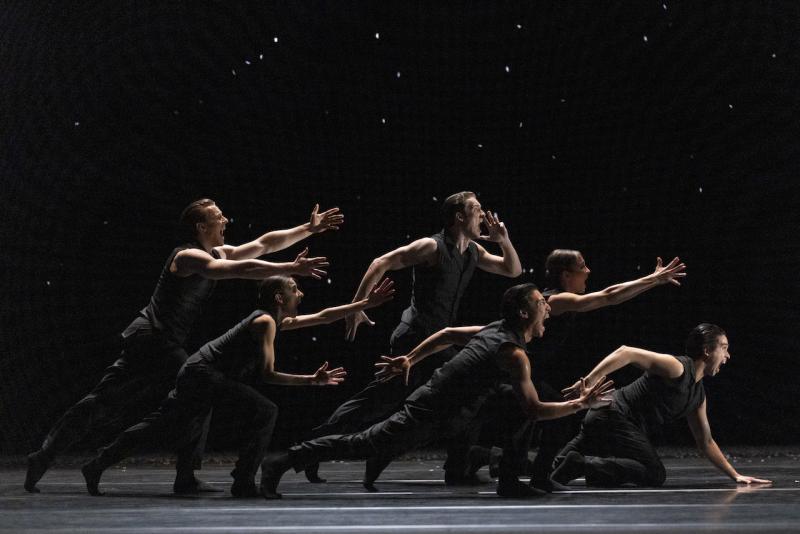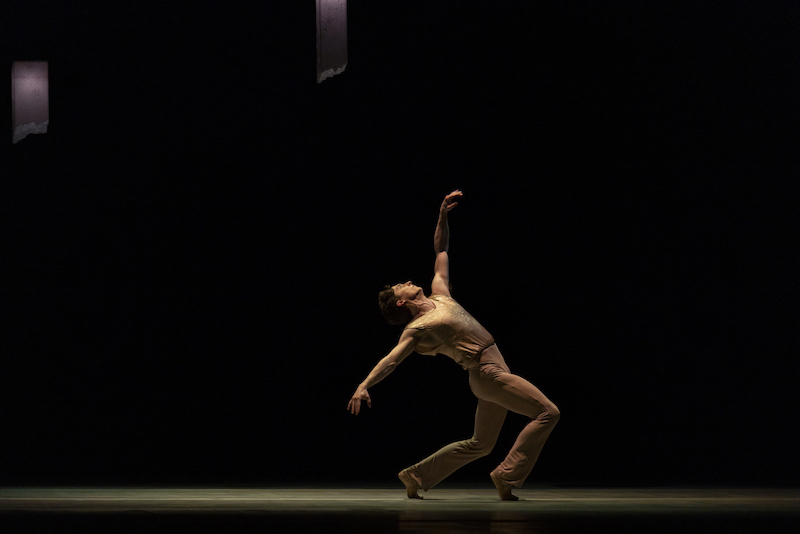The Weathering/Solo Echo/DGV, Royal Ballet review - the dancer as chameleon | reviews, news & interviews
The Weathering/Solo Echo/DGV, Royal Ballet review - the dancer as chameleon
The Weathering/Solo Echo/DGV, Royal Ballet review - the dancer as chameleon
Strong one-act works by Kyle Abraham and Crystal Pite show the dancers at their adaptive best

Of all the expectations one might have of a new ballet from a choreographer raised on street dance who has made work about the American prison system, serene loveliness isn’t one of them.
Abraham – who turns out to have a string of awards stateside and to have worked with some key ballet luminaries – is living proof that you don’t need to have grown up with the ballet canon to learn to speak the language. His first and only encounter with Giselle and Romeo and Juliet was on a visit to London earlier this year. Yet The Weathering, made for seven dancers, matched by seven instrumentalists in the orchestra pit, mines similar seams of love and devastating loss with a command of dynamics and texture that sets the stage alight.
 There is no narrative, yet within the work’s distinct sections are discernible life experiences – love affairs and friendships, illness and recovery, illness and death – threaded through with resilient optimism. In an exuberant solo, Anna Rose O’Sullivan reels off streams of bubbly piqué turns like a lark riding the thermals. Lines of boys leap and turn in joyful unison, and there’s an especially touching duet for Liam Boswell and Joshua Junker (pictured above), whose loosely twining upper body movements tell you at once about their intimacy. Dan Scully’s lighting scheme of lanterns, raised or lowered over a dark stage, tracks the changing moods.
There is no narrative, yet within the work’s distinct sections are discernible life experiences – love affairs and friendships, illness and recovery, illness and death – threaded through with resilient optimism. In an exuberant solo, Anna Rose O’Sullivan reels off streams of bubbly piqué turns like a lark riding the thermals. Lines of boys leap and turn in joyful unison, and there’s an especially touching duet for Liam Boswell and Joshua Junker (pictured above), whose loosely twining upper body movements tell you at once about their intimacy. Dan Scully’s lighting scheme of lanterns, raised or lowered over a dark stage, tracks the changing moods.
Ryan Lott’s musical score is an equal player, pitching a live ensemble of single strings and wind against a ghost ensemble that gives the aural impression of its instrumentalists roving the dress circle. I’m not sure on opening night that the levels were set quite right – a sforzando outburst of disembodied clarinet near my right shoulder gave me quite a fright, which I doubt was the intention. Such glitches are easily corrected. Lott’s music is of a quality that will repay a second and third hearing, a perfect match for Abraham’s choreography in its balance of beauty, innovation and surprise.
Crystal Pite’s Solo Echo – originally made for Nederlands Dans Theater – cleverly works the disjunct between that company’s exclamatory, almost cartoonish contemporary style and the melodious lushness of Brahms’ cello sonatas. The Royal Ballet first staged the piece last year but it remains astonishing that these dancers managed to overhaul their movement style from top to bottom to accommodate it – roughly akin to pro golfers turning themselves into soccer players in a matter of weeks. Watching the dancers' muscular antics (main image), pugilistic, hard-edged, low-slung, it’s hard to believe that they are currently also engaged in a long run of Swan Lake. Kudos too to cellist Christopher Vanderspar and pianist Robert Clark for their full-colour rendition of the Brahms.
The evening’s closer demands another style-change, but a less interesting one. The best thing about DGV: Danse à grande vitesse is its title, a twist on the TGV train for whose inauguration in the city of Lille Michael Nyman’s juggernaut of a score was commissioned in 1993. In his turn, Christopher Wheeldon clearly struggled to fill the stage with choreographic train-themed ideas, lumbered as he was with the wave upon wave of Nyman’s tediously chugging crescendos. As for Jean-Marc Puissant’s set, what looked like a train crash at the 2006 premiere still looks like a train crash. Even the luminous soloistic talents of Marianela Nunez and Yasmine Naghdi fail to make much impact with their long, lean, neo-classical balances – curiously static, going nowhere, and certainly not fast.
rating
Explore topics
Share this article
Add comment
The future of Arts Journalism
You can stop theartsdesk.com closing!
We urgently need financing to survive. Our fundraising drive has thus far raised £49,000 but we need to reach £100,000 or we will be forced to close. Please contribute here: https://gofund.me/c3f6033d
And if you can forward this information to anyone who might assist, we’d be grateful.

Subscribe to theartsdesk.com
Thank you for continuing to read our work on theartsdesk.com. For unlimited access to every article in its entirety, including our archive of more than 15,000 pieces, we're asking for £5 per month or £40 per year. We feel it's a very good deal, and hope you do too.
To take a subscription now simply click here.
And if you're looking for that extra gift for a friend or family member, why not treat them to a theartsdesk.com gift subscription?
more Dance
 'We are bowled over!' Thank you for your messages of love and support
Much-appreciated words of commendation from readers and the cultural community
'We are bowled over!' Thank you for your messages of love and support
Much-appreciated words of commendation from readers and the cultural community
 How to be a Dancer in 72,000 Easy Lessons, Teaċ Daṁsa review - a riveting account of a life in dance
Michael Keegan-Dolan's unique hybrid of physical theatre and comic monologue
How to be a Dancer in 72,000 Easy Lessons, Teaċ Daṁsa review - a riveting account of a life in dance
Michael Keegan-Dolan's unique hybrid of physical theatre and comic monologue
 A Single Man, Linbury Theatre review - an anatomy of melancholy, with breaks in the clouds
Ed Watson and Jonathan Goddard are extraordinary in Jonathan Watkins' dance theatre adaptation of Isherwood's novel
A Single Man, Linbury Theatre review - an anatomy of melancholy, with breaks in the clouds
Ed Watson and Jonathan Goddard are extraordinary in Jonathan Watkins' dance theatre adaptation of Isherwood's novel
 Peaky Blinders: The Redemption of Thomas Shelby, Rambert, Sadler's Wells review - exciting dancing, if you can see it
Six TV series reduced to 100 minutes' dance time doesn't quite compute
Peaky Blinders: The Redemption of Thomas Shelby, Rambert, Sadler's Wells review - exciting dancing, if you can see it
Six TV series reduced to 100 minutes' dance time doesn't quite compute
 Giselle, National Ballet of Japan review - return of a classic, refreshed and impeccably danced
First visit by Miyako Yoshida's company leaves you wanting more
Giselle, National Ballet of Japan review - return of a classic, refreshed and impeccably danced
First visit by Miyako Yoshida's company leaves you wanting more
 Quadrophenia, Sadler's Wells review - missed opportunity to give new stage life to a Who classic
The brilliant cast need a tighter score and a stronger narrative
Quadrophenia, Sadler's Wells review - missed opportunity to give new stage life to a Who classic
The brilliant cast need a tighter score and a stronger narrative
 The Midnight Bell, Sadler's Wells review - a first reprise for one of Matthew Bourne's most compelling shows to date
The after-hours lives of the sad and lonely are drawn with compassion, originality and skill
The Midnight Bell, Sadler's Wells review - a first reprise for one of Matthew Bourne's most compelling shows to date
The after-hours lives of the sad and lonely are drawn with compassion, originality and skill
 Ballet to Broadway: Wheeldon Works, Royal Ballet review - the impressive range and reach of Christopher Wheeldon's craft
The title says it: as dancemaker, as creative magnet, the man clearly works his socks off
Ballet to Broadway: Wheeldon Works, Royal Ballet review - the impressive range and reach of Christopher Wheeldon's craft
The title says it: as dancemaker, as creative magnet, the man clearly works his socks off
 The Forsythe Programme, English National Ballet review - brains, beauty and bravura
Once again the veteran choreographer and maverick William Forsythe raises ENB's game
The Forsythe Programme, English National Ballet review - brains, beauty and bravura
Once again the veteran choreographer and maverick William Forsythe raises ENB's game
 Sad Book, Hackney Empire review - What we feel, what we show, and the many ways we deal with sadness
A book about navigating grief feeds into unusual and compelling dance theatre
Sad Book, Hackney Empire review - What we feel, what we show, and the many ways we deal with sadness
A book about navigating grief feeds into unusual and compelling dance theatre
 Balanchine: Three Signature Works, Royal Ballet review - exuberant, joyful, exhilarating
A triumphant triple bill
Balanchine: Three Signature Works, Royal Ballet review - exuberant, joyful, exhilarating
A triumphant triple bill
 Romeo and Juliet, Royal Ballet review - Shakespeare without the words, with music to die for
Kenneth MacMillan's first and best-loved masterpiece turns 60
Romeo and Juliet, Royal Ballet review - Shakespeare without the words, with music to die for
Kenneth MacMillan's first and best-loved masterpiece turns 60

Comments
Thanks for the review. I